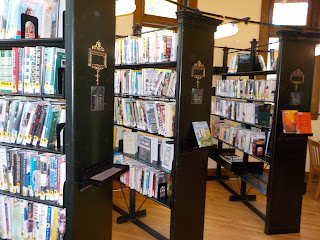Many of the libraries I visit are chosen quite by chance. Perhaps a library is close to another one; I like to visit two or three in a day trip. Never (rarely) more because the writing part gets burdensome. Perhaps I see an item in the paper about a library doing something interesting or new, and I put a day trip together from that beginning. In the case of Fobes Memorial, a picture in a book was the inspiration. The book is Libraries in New England, written by Margaret Haller and published in 1991. I'd never heard of Oakham, Massachusetts, but MapQuest solved that. So far, so good. Other libraries close by? Yes indeed. And finally, are all three open on the same day of the week? Yes!
Why did this library catch my eye as I paged through the book? The stones! It's just such a great stone building. But wait...the book was published 32 years ago. Would the building still be there? Would it still be in use as a library? Google time. Great, the Oakham library has a web page. Based on a picture, the handsome stone building is still in use as a library; there is a street address for my GPS. And best of all, it's open on the same days as the other two chosen for this trip. Let's go!
I once took a course in architectural design for non-architect types, and the one thing I remember is the importance of a sense of entry. This is a great example.
The interior looks just as I hoped it would. It's attractively furnished,
has a quilt and several fireplaces,
and has a wooden train set to keep the littles entertained while the adults do adult stuff.
This corner holds a computer for patrons to use. If memory serves, the three colors
on the screen represent three general functions: catalog, searching, and ? It seems that memory does not choose to serve at the moment.
The stacks are standing by for browsers.
We'll visit the lower level shortly, but not via this great curved stairway.
I remember just once in my life that I made a call on a phone like this. There has been some research that says humans are hard-wired to see "faces" everywhere. This phone is a great example.
Here's a classic view of the main level. Books, tables, natural light from the large windows.
Since my knees quailed at the thought of the stairs, I rode down in this elevator. It is very slow and very quiet. If you look closely you can see a black switch just beyond the yellow switch. To go down, you have to hold the black switch down. This is definitely a candidate for my (imaginary) hall of fame for things I've never seen before.
This building set at the botton of the stairs is a castle, very popular with the kids. I wonder if they think of the library building as a castle, with its round tower and all? Surely they do!
I know from the sign that there are new books here. But I don't recall anything about the bottles. Somebody, help! Use the comments and help me out here.
A classic puppet theater is waiting for young puppeteers in the children's area.
There is a collection of STEM kits to borrow. I spotted labels on two, Early Coding and Volcanoes.. Just about every library I visit is doing something with Science, Technology, Engineering, and Math. When I discuss this with library folks, it seems that these materials are coming from grants. Along with everything else, a librarian needs to be a talented grant-writer!
These other loanable kits are called "Sensory Kits." I'm not sure what that means. I did a bit of googling and figured out that they are hands-on activities, no screens involved. More grant writing, I'm sure.
Before leaving I snapped this picture of the staircase. I think my knees would have done just fine, as the steps are deep and not too high and the railings are great.
The library website has a nice history of the library. It was built in 1907 but was active long before that. So my concern that it might not still be standing was quite unfounded. It's well along in its second century.
5/17/2023























For a little library this seem very well prepared for a variety of uses. I love the stones, are they ballast stones?
ReplyDelete